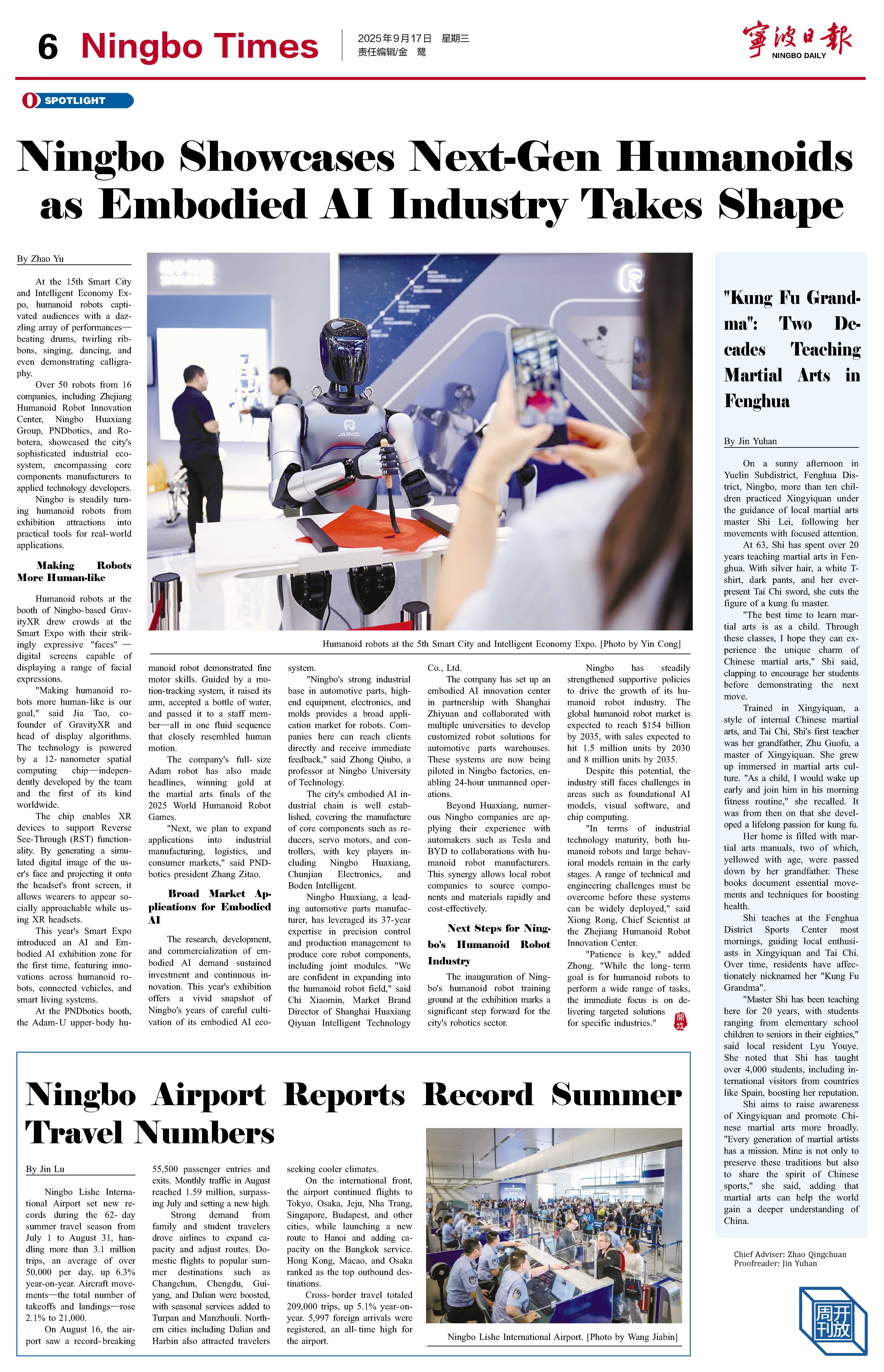By Zhao Yu
At the 15th Smart City and Intelligent Economy Expo, humanoid robots captivated audiences with a dazzling array of performances—beating drums, twirling ribbons, singing, dancing, and even demonstrating calligraphy.
Over 50 robots from 16 companies, including Zhejiang Humanoid Robot Innovation Center, Ningbo Huaxiang Group, PNDbotics, and Robotera, showcased the city's sophisticated industrial ecosystem, encompassing core components manufacturers to applied technology developers.
Ningbo is steadily turning humanoid robots from exhibition attractions into practical tools for real-world applications.
Making Robots More Human-like
Humanoid robots at the booth of Ningbo-based GravityXR drew crowds at the Smart Expo with their strikingly expressive "faces"—digital screens capable of displaying a range of facial expressions.
"Making humanoid robots more human-like is our goal," said Jia Tao, co-founder of GravityXR and head of display algorithms. The technology is powered by a 12-nanometer spatial computing chip—independently developed by the team and the first of its kind worldwide.
The chip enables XR devices to support Reverse See-Through (RST) functionality. By generating a simulated digital image of the user's face and projecting it onto the headset's front screen, it allows wearers to appear socially approachable while using XR headsets.
This year's Smart Expo introduced an AI and Embodied AI exhibition zone for the first time, featuring innovations across humanoid robots, connected vehicles, and smart living systems.
At the PNDbotics booth, the Adam-U upper-body humanoid robot demonstrated fine motor skills. Guided by a motion-tracking system, it raised its arm, accepted a bottle of water, and passed it to a staff member—all in one fluid sequence that closely resembled human motion.
The company's full-size Adam robot has also made headlines, winning gold at the martial arts finals of the 2025 World Humanoid Robot Games.
"Next, we plan to expand applications into industrial manufacturing, logistics, and consumer markets," said PNDbotics president Zhang Zitao.
Broad Market Applications for Embodied AI
The research, development, and commercialization of embodied AI demand sustained investment and continuous innovation. This year's exhibition offers a vivid snapshot of Ningbo's years of careful cultivation of its embodied AI ecosystem.
"Ningbo's strong industrial base in automotive parts, high-end equipment, electronics, and molds provides a broad application market for robots. Companies here can reach clients directly and receive immediate feedback," said Zhong Qiubo, a professor at Ningbo University of Technology.
The city's embodied AI industrial chain is well established, covering the manufacture of core components such as reducers, servo motors, and controllers, with key players including Ningbo Huaxiang, Chunjian Electronics, and Boden Intelligent.
Ningbo Huaxiang, a leading automotive parts manufacturer, has leveraged its 37-year expertise in precision control and production management to produce core robot components, including joint modules. "We are confident in expanding into the humanoid robot field," said Chi Xiaomin, Market Brand Director of Shanghai Huaxiang Qiyuan Intelligent Technology Co., Ltd.
The company has set up an embodied AI innovation center in partnership with Shanghai Zhiyuan and collaborated with multiple universities to develop customized robot solutions for automotive parts warehouses. These systems are now being piloted in Ningbo factories, enabling 24-hour unmanned operations.
Beyond Huaxiang, numerous Ningbo companies are applying their experience with automakers such as Tesla and BYD to collaborations with humanoid robot manufacturers. This synergy allows local robot companies to source components and materials rapidly and cost-effectively.
Next Steps for Ningbo's Humanoid Robot Industry
The inauguration of Ningbo's humanoid robot training ground at the exhibition marks a significant step forward for the city's robotics sector.
Ningbo has steadily strengthened supportive policies to drive the growth of its humanoid robot industry. The global humanoid robot market is expected to reach $154 billion by 2035, with sales expected to hit 1.5 million units by 2030 and 8 million units by 2035.
Despite this potential, the industry still faces challenges in areas such as foundational AI models, visual software, and chip computing.
"In terms of industrial technology maturity, both humanoid robots and large behavioral models remain in the early stages. A range of technical and engineering challenges must be overcome before these systems can be widely deployed," said Xiong Rong, Chief Scientist at the Zhejiang Humanoid Robot Innovation Center.
"Patience is key," added Zhong. "While the long-term goal is for humanoid robots to perform a wide range of tasks, the immediate focus is on delivering targeted solutions for specific industries."



